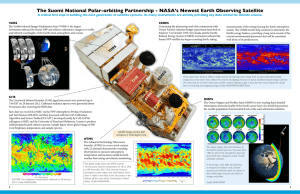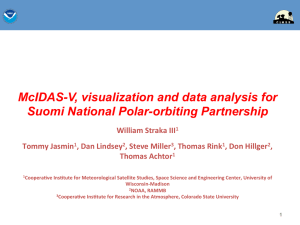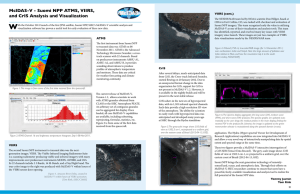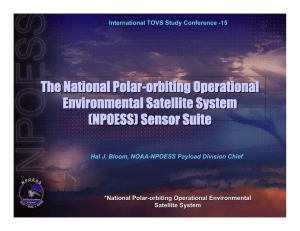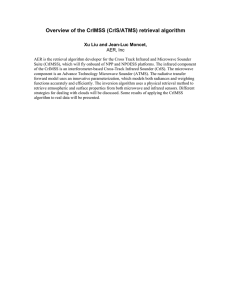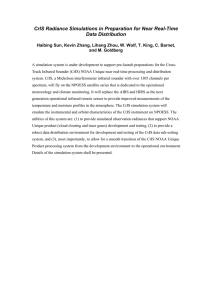SUOMI National Polar-orbiting Program Status and Instrument Performance
advertisement
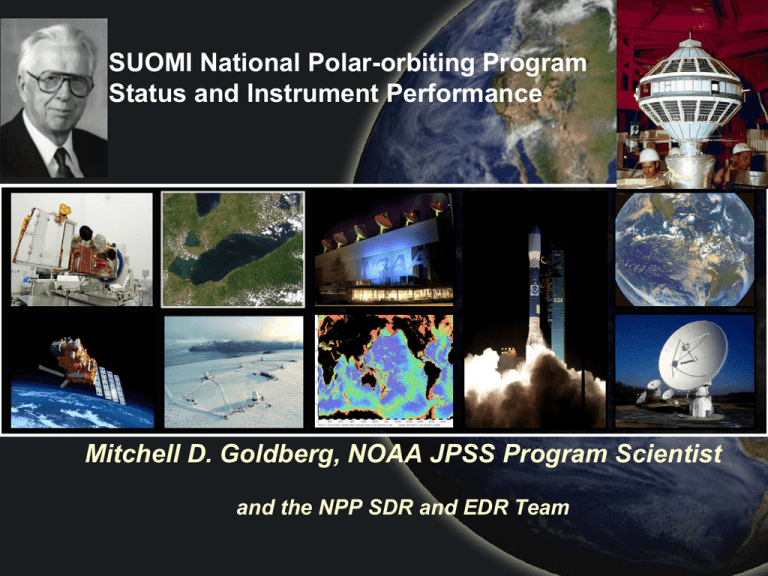
SUOMI National Polar-orbiting Program Status and Instrument Performance Mitchell D. Goldberg, NOAA JPSS Program Scientist and the NPP SDR and EDR Team The Team ● NOAA, NASA, NRL, FNMOC, NAVO, AFWA ● Cooperative Institutes (CIMSS, CIRA, CICS) ● UMBC, HU, UTAH SDL, MIT-LL, AEROSPACE, NGAS, Miami, …… ● Raytheon ● External users: UKMO, ECMWF 2 TOPICS Overview of the NPP Instruments, Products, Processing System Initial Results from VIIRS, ATMS, CrIS, OMPS and CERES Courtesy of Ben Cooper LAUNCH October 28, 2011!!!! SUCCESSFUL 3 NPP/JPSS Instruments JPSS Instrument ATMS CrIS VIIRS Measurement NOAA Heritage NASA Heritage ATMS and CrIS together provide profiles of high vertical resolution atmospheric temperature and water vapor information AMSU AMSU HIRS AIRS AVHRR MODIS SBUV-2 OMI Provides daily high-resolution imagery and radiometry across the visible to long-wave infrared spectrum for a multitude of environmental assessments OMPS Spectrometers with UV bands for ozone total column measurements CERES Scanning radiometer which supports studies of Earth Radiation Budget Joint Polar Satellite System CERES 5 NPP Spacecraft (JPSS-1 Concept ) VIIRS CrIS OMPS ATMS CERES 6 JPSS Constellation 2011 2012 2013 2014 2015 2016 2017 2018 2019 2020 2021 2022 2023 2024 2025 2026 MetOp-A MetOp-B MetOp-C EPS-SG NOAA-19 NPP JPSS-1 JPSS-2 GCOM W-1 thr GCOM W1, W2, W3 Free-Flyer 8 Functional Scope: The NESDIS Central NOAA Satellite Operations Facility (NSOF) Suitland, MD xDRs NASA Science Data Segment (SDS) JPSS Interface Data Processing Segment (IDPS) NOAA Environmental Satellite Processing Center (ESPC) Algorithm Development xDR Subscription Requests xDRs Data Delivery Reports JPSS Mission Management Center (MMC) NOAA-Unique Products NPP Status Work Request/ Status • Data Center Operations • Telecommunications NOAA NPP Data Exploitation (NDE) NOAA xDRs Tailored Products User Services Request/ Response Product Processing Components NOAA-Unique Products xDRs • User Services (Help Desk) • Config. Management • Security Controls • Distribution • Ingest Center for Satellite Applications and Research (STAR) and partners provides: • Validation of sensor and environmental data records End-users (NWS, NOS, OAR, & external users) Office of Satellite & Product Operations NDE (OSPO) will provide common services: Long-Term Archive (CLASS) • Algorithm development and improvements • Supports both JPSS 9 IDPS and NDE Derived Products ESPC GCOM AMSR-2 (11) VIIRS (22) ALBEDO (SURFACE) CLOUD BASE HEIGHT CLOUD COVER/LAYERS CLOUD EFFECTIVE PART SIZE CLOUD OPTICAL THICKNESS CLOUD TOP HEIGHT CLOUD TOP PRESSURE CLOUD TOP TEMPERATURE ICE SURFACE TEMPERATURE NET HEAT FLUX OCEAN COLOR/CHLOROPHYLL A-DCS IMAGERY SEA ICE CHARACTERIZATION SNOW COVER/DEPTH SEA SURFACE TEMPERATURE SURFACE TYPE IMAGERY SEA ICE CHARACTERIZATION SNOW COVER SEA SURFACE TEMPERATURE LAND SURFACE TEMP SURFACE TYPE CrIS/ATMS (3) OMPS (2) O3 TOTAL COLUMN O3 NADIR PROFILE CLOUD LIQUID WATER PRECIPITATION TYPE/RATE PRECIPITABLE WATER SEA SURFACE WINDS SPEED SOIL MOISTURE SNOW WATER EQUIVALENT SUSPENDED MATTER VEGETATION INDEX AEROSOL OPTICAL THICKNESS AEROSOL PARTICLE SIZE ACTIVE FIRES CERES (4) DOWN LW RADIATION (SFC) DOWN SW RADIATION (SFC) NET SOLAR RADIATION (TOA) OUTGOING LW RADIATION (TOA) ATM VERT MOIST PROFILE ATM VERT TEMP PROFILE PRESSURE (SURFACE/PROFILE) SARR & SARP TSIS (1) SOLAR IRRADIANCE KEY Joint Polar Satellite System EDRs with Key Performance Parameters JPSS-1 JPSS Program (Host TBD) GCOM 10 Direct Readout Stations using Xband NDE MeteoFrance DB UW CIMSS providing the Community Satellite Processing Package Cross-Track Infrared Sounder (CrIS) NPOESS Preparatory Satellite – Launch: October 2011 NPP/JPSS CrIS • Michelson Interferometer: 0.625,1.25, 2.5cm-1 (resolving power of 1000) • Spectral range: 660-2600 cm-1 • 3 x 3 HdCdTe focal plane passively cooled (4-stages) to 85K • Focal plane 27 detectors, 1305 spectral channels • 310 K Blackbody and space view provides radiometric calibration • NEDT ranges from 0.05 K to 0. 5 K AIRS IASI CrIS “CrIS LW Noise << AIRS & IASI LW Noise” 12 13 CrIS RTV for 20 Jan 2012, t1910005 Single profiles Courtesy: Dave Tobin, Bill Smith Elisabeth Weisz 18 CrIS RTV for 20 Jan 2012, t1254026 Temperature and Humidity 19 CrIS 20 Jan 2012, t1254026 Cloud Top pressure and Cloud Optical Thickness 20 CrIS RTV for 20 Jan 2012, t1254026 Temperature and Relative Humidity Cross-sections Scanline 120 21 CrIS/AIRS BT Comparison AIRS Window Channel Tb (K) AIRS Water Vapor Channel Tb (K) 6:30 UTC 6:30 UTC 6:36 UTC 6:36 UTC 6:42 UTC 03/12/2012 6:42 UTC Two Granules CrIS/AIRS BT Comparison CrIS Window Channel Tb (K) 6:28 UTC 6:34 UTC 6:40 UTC 03/12/2012 CrIS Water Vapor Channel Tb (K) 6:28 UTC 6:34 UTC 6:40 UTC Comparison of CriS and AIRS for LW Window 24 ATMS Design Challenge AMSU-A1 • • • • 73x30x61 cm 67 W 54 kg 3-yr life • • • • 75x70x64 cm 24 W 50 kg 3-yr life • • • • 75x56x69 cm 61 W 50 kg 4-yr life Reduce the volume by 3x AMSU-A2 MHS Figure courtesy NGES, Azusa, CA – – – – 70x40x60 cm 110 W 85 kg 8 year life 25 Spectral Differences: ATMS vs. AMSU/MHS MHS AMSU-A AMSU/MHS ATMS Ch GHz Pol Ch GHz Pol 1 23.8 QV 1 23.8 QV 2 31.399 QV 2 31.4 QV 3 50.299 QV 3 50.3 QH 4 51.76 QH 4 52.8 QV 5 52.8 QH 5 53.595 ± 0.115 QH 6 53.596 ± 0.115 QH 6 54.4 QH 7 54.4 QH 7 54.94 QV 8 54.94 QH 8 55.5 QH 9 55.5 QH 9 fo = 57.29 QH 10 fo = 57.29 QH 10 fo ± 0.217 QH 11 fo±0.3222±0.217 QH 11 fo±0.3222±0.048 QH 12 fo± 0.3222±0.048 QH 12 fo ±0.3222±0.022 QH 13 fo±0.3222±0.022 QH 13 fo± 0.3222±0.010 QH 14 fo±0.3222 ±0.010 QH 14 fo±0.3222±0.004 5 QH 15 fo± 0.3222±0.0045 QH 15 89.0 QV 16 89.0 QV 16 88.2 QV 17 157.0 QV 17 165.5 QH 18 183.31 ± 1 QH 18 183.31 ± 7 QH 19 183.31 ± 3 QH 19 183.31 ± 4.5 QH 20 191.31 QV 20 183.31 ± 3 QH 21 183.31 ± 1.8 QH 22 183.31 ± 1 QH • ATMS has 22 channels and AMSU/MHS have 20, with polarization differences between some channels − QV = Quasi-vertical; polarization vector is parallel to the scan plane at nadir − QH = Quasi-horizontal; polarization vector is perpendicular to the scan plane at nadir Exact match to AMSU/MHS Only Polarization different Unique Passband Unique Passband, and Pol. different from closest AMSU/MHS channels 26 Microwave Temperature Sounding Vertical Resolution MSU+SSU (1978-2007) 27 Spatial Differences: ATMS vs. AMSU/MHS Beamwidth (degrees) Spatial sampling ATMS AMSU/MHS ATMS AMSU/MHS 23/31 GHz 5.2 3.3 23/31 GHz 1.11 3.33 50-60 GHz 2.2 3.3 50-60 GHz 1.11 3.33 89-GHz 2.2 1.1 89-GHz 1.11 1.11 160-183 GHz 1.1 1.1 160-183 GHz 1.11 1.11 Swath (km) ~2600 ~2200 ATMS scan period: 8/3 sec; AMSU-A scan period: 8 sec ATMS measures 96 footprints per scan (30/90 for AMSU-A/B) 28 NOAA, NPP and FY-3 MW Sounder FOV ATMS beam width 1.1o ATMS MWTS AMSU-A ATMS beam width 5.2o ATMS beam width 2.2o 29 ATMS Storm Mapping: Improvements Relative to AMSU Source: Surussavadee and Staelin, NASA PMM Presentation, 7/08 30 STAR ICVS Website 31 32 33 First global ATMS image showing the channel 18microwave antenna temperature at 183.3 GHz on November 8, 2011 The ATMS data were processed at the NOAA Satellite Operations Facility (NSOF) in Suitland, MD and the image was generated by STAR Quality of the image is superb, no indication of instrument artifacts, and by design no orbital gaps This channel measures atmospheric water vapor; note that Tropical Storm Sean is visible in the data, as the blue patch due to heavy precipitation, in the Atlantic off the coast of the Southeastern United States. ATMS provides critical water vapor information for weather forecasting and storm intensity assessments 34 NOAA ATMS MIRS Products TPW T WV RR Courtesy of Sid Boukabara (STAR) 35 ATMS has better spatial resolution and no gaps 36 LIMB ADJUSTMENT - TRANSFORMING A CROSS TRACK SENSOR TO AN IMAGER Visible Infrared Imaging Radiometer Suite Raytheon SAS El Segundo, Ca Description • Purpose: Global observations of land, ocean, & atmosphere parameters at high temporal resolution (~ daily) • Predecessor Instruments: AVHRR, OLS, MODIS, SeaWiFS • Approach: Multi-spectral scanning radiometer (22 bands between 0.4 µm and 12 µm) 12-bit quantization • Swath width: 3000 km Spatial Resolution • 16 bands at 750m • 5 bands at 325m • DNB VIIRS on NPP 38 VIIRS Prelaunch Performance (NPP F1 Bands and SNR/NEDT) Specification Band No. VisNIR S/WMIR Band Gain Ltyp or Ttyp (Spec) Lm ax or Tm ax SNR or NEdT (K) Measured SNR or NEdT (K) SNR Margin (%) High Low High Low High Low 44.9 155 40 146 32 123 135 615 127 687 107 702 352 316 380 409 416 414 723 1327 576 1076 658 1055 105% 320% 51.5% 163% 58.2% 155% High Low 21 90 78 667 362 315 558 882 54.1% 180% Single High Low 22 10 68 718 59 651 119 242 360 265 360 847 122.7% 49% 135% 0.402 - 0.422 0.742 x 0.259 1.60 x 1.58 0.436 - 0.454 0.742 x 0.259 1.60 x 1.58 0.478 - 0.498 0.742 x 0.259 1.60 x 1.58 0.545 - 0.565 0.742 x 0.259 1.60 x 1.58 0.600 - 0.680 0.371 x 0.387 0.80 x 0.789 M5 Im agery EDR Ocean Color Aerosol 0.662 - 0.682 0.742 x 0.259 1.60 x 1.58 M6 Atm osph. Correct. 0.739 - 0.754 0.742 x 0.776 1.60 x 1.58 Single 9.6 41 199 394 98.0% I2 0.846 - 0.885 0.371 x 0.387 0.80 x 0.789 M7 NDVI Ocean Color Aerosol 0.846 - 0.885 0.742 x 0.259 1.60 x 1.58 Single High Low 25 6.4 33.4 349 29 349 150 215 340 299 545 899 99.3% 154% 164% M8 Cloud Particle Size 1.230 - 1.250 0.742 x 0.776 1.60 x 1.58 Single 5.4 165 74 349 371.6% M9 Cirrius/Cloud Cover 1.371 - 1.386 0.742 x 0.776 1.60 x 1.58 Single 6 77.1 83 247 197.6% I3 Binary Snow Map 1.580 - 1.640 0.371 x 0.387 0.80 x 0.789 Single 7.3 72.5 6 165 2650.0% M10 Snow Fraction 1.580 - 1.640 0.742 x 0.776 1.60 x 1.58 Single 7.3 71.2 342 695 103.2% M11 Clouds 2.225 - 2.275 0.742 x 0.776 1.60 x 1.58 Single 0.12 31.8 10 18 80.0% I4 Im agery Clouds 3.550 - 3.930 0.371 x 0.387 0.80 x 0.789 Single 270 353 2.5 0.4 84.0% M12 SST SST Fires 3.660 - 3.840 0.742 x 0.776 1.60 x 1.58 3.973 - 4.128 0.742 x 0.259 1.60 x 1.58 Single High Low 270 300 380 353 343 634 0.396 0.107 0.423 0.12 0.044 -- 69.7% 59% -- 8.400 - 8.700 M3 M4 Ocean Color Aerosol I1 M13 LWIR Horiz Sam ple Interval (km ) (track x Scan) End of Scan M2 Reflective Bands Spectral Range (um ) Nadir Ocean Color Aerosol Ocean Color Aerosol Ocean Color Aerosol M1 Emissive Bands Driving EDR(s) M14 M15 I5 M16 0.742 x 0.776 1.60 x 1.58 Single 270 336 0.091 0.054 40.7% SST 10.263 - 11.263 0.742 x 0.776 1.60 x 1.58 Single 300 343 0.07 0.028 60.0% Cloud Im agery 10.500 - 12.400 0.371 x 0.387 0.80 x 0.789 Single 210 340 1.5 0.41 72.7% SST 11.538 - 12.488 0.742 x 0.776 1.60 x 1.58 Single 300 340 0.072 0.036 50.0% Cloud Top Properties HSI uses 3 in-scan pixels aggregation at Nadir Courtesy of H. Oudrari 39 Comparison of “Imagery” Bands at Nadir Wavelength AVHRR MODIS VIIRS .63 µm .86 µm 1.6 µm 3.7 µm 11.4 µm 1.1 AVHRR km 0.25 – 1 km 0.37 km 41 VIIRS has a very large cross track and near constant spatial resolution 42 First Global VIIRS Image VIIRS 46 NPP VIIRS True Color Examples Colorado 11.24.2011 1845 Z, Near Edge of Scan 11.24.2011 2028 UTC, Near Nadir VIIRS maintains similar spatial resolution quality at edge of 3000 km swath 47 NPP VIIRS True Color Examples Edge of Scan Intercomparisons Aqua MODIS 11-24-11 1840Z NPP VIIRS 11-24-11 1845Z NOAA-19 AVHRR 11-24-11 2000Z 48 Multi-spectral Comparisons True color - Northeast US 4 9 Multi-spectral Comparisons True color – New Orleans MODIS 1840z VIIRS 1845Z Resolution consistency across swath bodes well for AMV fidelity 5 0 VIIRS Day Night Band Chicago Atlanta Dallas Miami New Orleans VIIRS Nighttime Visible - DNB OLS 08:44Z DNB 0718Z Geolocation not corrected Enhanced city light definition due to spatial resolution and quantizatio n 52 Moonlight Imagery Nighttime Imagery: 1/5/2012 0053 UTC, Mediterranean Region Turkey Italy Greece Spain North Africa Saudi Arabia Moonglint scenes showcase the tremendous dynamic range and radiometric resolution of the new DNB sensor. 53 Moonlight Imagery Nighttime Imagery: 1/5/2012 0920 UTC, Western U.S. Salt Lake City Denver San Francisco Las Vegas Los Angeles Phoenix 54 Dust Storm Nighttime Imagery: 1/7/2012 2359 UTC, Eastern Mediterranean Cairo 55 Volcanic Ash Puyehue-Cordon Caulle Volcanic Chain 12-13 Dec 2011 Afternoon Night Morning (???) Nighttime pass fills in the temporal gap between last PM and first available AM visible-light observations. 56 The Korean Strait Squid Fishing Boats 57 VIIRS Nighttime Visible - DNB Tropical Cyclone 06S Heidi VIIRS 1750 OLS 2005 OLS 2129 58 OMPS Instrument Design Nadir Mapper UV Backscatter, grating spectrometer, 2-D CCD TOMS, SBUV(/2), GOME(-2), OMI 110 deg. cross track, 300 to 380 nm spectral, 1.1nm FWHM bandpass Total Column Ozone, UV Effective Reflectivity, and Aerosol Index Daily Maps Nadir Profiler UV Backscatter, grating spectrometer, 2-D CCD SBUV(/2), GOME(-2), OMI Nadir view, 250 km cross track, 270 to 310 nm spectral, 1.1 nm FWHM bandpass Ozone Vertical Profile, 7 to 10 KM resolution Limb Profiler UV/Visible Limb Scatter, prism, 2-D CCD array SOLSE/LORE, OSIRIS, SAGE III, SCIAMACHY Three 100-KM vertical slits, 290 to 1000 nm spectral Ozone Vertical Profile, 3 KM vertical resolution The calibration concepts use working and reference solar diffusers. 59 Instrument and FOV59 Graphics from BATC OMPS provides continuity of essential ozone products and applications Monitoring ozone hole and recovering of ozone due to the Montreal Protocol for eliminating Chlorofluorocarbons (CFCs) Used in NWS UV Index forecast to allow public to avoid overexposure to UV radiation 60 Ozone Monitoring and Profiling Suite Regular Operations: January 27, 2012 OMPS First Light Research Algorithms February 2, 2012 OMPS First Operational Data JPSS GAO Polar Satellite Transition, Status, and Risks (311250) *** For Official Use Only – Not for Public Consumption *** 61 Ozone Profile and OMPS Limb Photo taken from ISS February 2, 2012 JPSS GAO Polar Satellite Transition, Status, and Risks (311250) *** For Official Use Only – Not for Public Consumption *** 62 CERES Instrument Overview CERES scanning radiometer measuring three spectral bands at TOA 21 in. – Total (0.3 to >50 µm) – Shortwave (0.3 to 5.0 µm) – Longwave (5 to 50 µm) Operations, Data Processing, Products, and Science are a continuation of experience developed on 22 in. – TRMM (1), EOS Terra (2), EOS Aqua (2), in I&T on NPP Critical Resource Margins Primary CERES Climate Data Records CERES Value Allocation Margin Mass, kg Power: Operational, Watts Power: Peak, Watts Power: Survival, Watts Heat Transfer - Hot Case, Watts Heat Transfer - Cold Case, Watts 46.8 45.85 60 39.5 4.1 -1.7 54 50 75 40 ±5 W ±5 W 13.3% 8.3% 20.0% 1.3% 18.0% 66.0% Data Rate, Kb / sec Pointing Control, arcsec Pointing Knowledge, arcsec 10 < 114 < 107 10 194 180 0 41.2% 40.6% Reflected Solar Energy Emitted Thermal Energy 63 Earth Radiation Budget CERES Shortwave From IPCC AR4 FAQ TSIS CERES Longwave 64 CERES Flight Model 5 First Light Data: January 26, 2012 Reflected Solar Energy CERES scanning radiometer measuring three spectral bands at TOA – Total (0.3 to >50 µm) – Shortwave (0.3 to 5.0 µm) – Longwave Bandpass (8 to 12 µm) Emitted Thermal Energy Operations, Data Processing, Products, and Science are a continuation of experience developed on – TRMM (1), EOS Terra (2), EOS Aqua (2) February 2, 2012 JPSS GAO Polar Satellite Transition, Status, and Risks (311250) *** For Official Use Only – Not for Public Consumption *** 65 Overview of AMSR2 instrument on GCOM Deployable main reflector system with 2.0m diameter. Frequency channel set is identical to that of AMSR-E except 7.3GHz channel for RFI mitigation. 2-point external calibration with the improved HTS (hot-load). Deployed Stowed AMSR2 Channel Set AMSR2 characteristics Scan Conical scan Swath width 1450km Antenna 2.0m offset parabola Digitalization 12bit Incidence angle nominal 55 degree Polarization Vertical and Horizontal Dynamic range 2.7-340K Center Freq. [GHz] Band width [MHz] 6.925/ 7.3 350 10.65 100 18.7 200 23.8 400 36.5 1000 0.35 (7 x 12) 89.0 3000 0.15 (3 x 5) Polariz ation Beam width [deg] (Ground res. [km]) Sampling interval [km] 1.8 (35 x 62) 1.7 (34 x 58) V and H 1.2 (24 x 42) 0.65 (14 x 22) 10 0.75 (15 x 26) 66 5 66 Overview of AMSR2 Products Geophysical products Integrated water vapor Integrated cloud liquid water Precipitation Sea surface temperature Sea surface wind speed Sea ice concentration Snow depth Soil moisture Comments Over global ocean*, columnar integrated value Over global ocean*, columnar integrated value Global (except over ice and snow), surface rain rate Global ocean* Global ocean* High latitude ocean areas Land surface (except dense forest regions) Land surface (except ice sheet and dense forest regions) Water vapor Cloud liquid water Snow water equivalent Soil moisture Precipitation Sea ice concentration Sea surface Wind vector Sea surface temperature 67 Conclusions JPSS Mission will provide: Input Observations for Weather Forecast Models CrIS, ATMS, VIIRS, OMPS & GCOM Short term Environmental Observations (Events) VIIRS, OMPS, CrIS, ATMS & GCOM Long term Environmental Observations (Climate Change Detection) CERES, TSIS, VIIRS, OMPS, CrIS, ATMS & GCOM User Engagement is critical for ultimate mission success 68 Backup 69 User Engagement & Feedback Sustaining User Engagement is part of the JPSS Program Demonstrate importance of NPP data to the Nation and to critical operational product and services and for improved research Established a JPSS Proving Ground to focus on improved utilization of NPP/JPSS data for key application areas 70 Application Areas ●Tropical Cyclone Applications ●Cryosphere Applications ●Severe Weather/Aviation Applications ●Ocean/Coastal Applications (Coral Bleaching, Harmful Algae Bloom alerts) ●Land Applications (Agriculture, Droughts) ●Hazards Applications (Smoke, Fire, Aerosols, Air Quality, Flash Floods) ●Data Assimilation Applications ●Imagery/Visualization Applications ●Climate Applications 71 Backup Slides 72 AVHRR 1 2 3 4 5 580 - 680 840 - 940 3.55 - 3.93 10.3 - 11.3 11.5 - 12.5 MODIS 8 9 10 12 1 13 15 16 2 5 26 6 7 20 23 29 31 32 33 34 35 36 405 - 420 438 - 448 483 - 493 546 - 556 620 - 670 662 - 672 743 - 753 862 - 877 841 - 877 1.23 - 1.25 1.36 - 1.39 1.63 - 1.65 2.11 - 2.16 3.66 - 3.84 4.02 - 4.08 8.40 - 8.70 10.78 - 11.28 11.77 - 12.27 13.2 – 13.5 13.5 – 13.8 13.8 – 14.1 14.1 – 14.4 VIIRS M1 402 – 422 (750m) M2 436 - 464 M3 478 - 498 M4 545 - 565 I1 580 – 680 (375m) M5 662 - 682 M6 744 - 758 M7 845 - 885 I2 845 - 885 M8 1.23 - 1.25 M9 1.371 - 1.385 M10 1.58 - 1.64 I3 1.58 - 1.64 M11 2.235 - 2.285 M12 3.61 - 3.79 I4 3.55 - 3.93 M13 3.97 - 4.13 M14 8.40 - 8.7 M15 10.3 - 11.3 M16 11.5 - 12.5 I5 10.6 - 12.5 ABI 1 2 3 4 5 6 7 8 9 10 11 12 13 14 15 16 450 – 490 (1km) 590 – 690 (.5) 846 – 885 (1) 1.37-1.39 (2) 1.58 - 1.64 (1) 2.23 – 2.28 (2) 3.8 – 4.0 5.77 – 6.6 6.75 – 7.15 7.24 – 7.44 8.3 – 8.7 9.42 – 9.8 10.1 – 10.6 10.8 – 11.6 11.8 – 12.8 13.0 – 13.6 73 VIIRS Improvements From AVHRR: Radiometric properties Greater spectral coverage with increased radiometric quality VIIRS MODIS Equivalent Band Range (um) HSR (m) DNB 0.500 - 0.900 750 M1 M2 0.402 - 0.422 0.436 - 0.454 750 750 M3 0.478 - 0.498 750 M4 0.545 - 0.565 750 I1 0.600 - 0.680 375 M5 0.662 - 0.682 750 M6 I2 M7 M8 M9 I3 M10 M11 I4 M12 0.739 0.846 0.846 1.230 1.371 1.580 1.580 2.225 3.550 3.660 0.754 0.885 0.885 1.250 1.386 1.640 1.640 2.275 3.930 3.840 750 375 750 750 750 375 750 750 375 750 M13 3.973 - 4.128 750 M14 M15 8.400 - 8.700 10.263 - 11.263 750 750 0.405 - 0.420 0.438 - 0.448 0.459 - 0.479 0.483 - 0.493 0.545 - 0.565 4 12 0.546 - 0.556 1 0.620 - 0.670 0.662 - 0.672 13 0.673 - 0.683 14 15 0.743 - 0.753 2 0.841 - 0.876 16 0.862 - 0.877 5 SAME 26 1.360 - 1.390 6 1.628 - 1.652 6 1.628 - 1.652 7 2.105 - 2.155 20 3.660 - 3.840 20 SAME 3.929 - 3.989 21 22 3.929 - 3.989 23 4.020 - 4.080 29 SAME 31 10.780 - 11.280 I5 10.500 - 12.400 375 31 M16 11.538 - 12.488 750 - Band Range AVHRR-3 Equivalent HSR Band Range HSR Low light capabilities 8 9 3 10 32 32 OLS Equivalent Band HRD PMT Range 0.580 - 0.910 0.510 - 0.860 HSR 550 2700 1000 1000 Ocean Color, Aerosol 500 1000 500 1000 250 1 0.572 - 0.703 1100 1000 1000 1 0.572 - 0.703 1100 1000 250 1000 500 1000 500 500 500 1000 1000 2 2 3a 3b 3b 1000 1000 1000 1000 1000 Atm Correction 0.720 - 1.000 1100 0.720 - 1.000 1100 Cloud Particle Size Thin Cirrus Snow Map SAME 1100 Cloud SAME 1100 3.550 - 3.930 1100 SST, Fire 4 Cloud Top Propoerties 10.300 - 11.300 1100 10.780 - 11.280 11.770 - 12.270 1000 1000 4 5 10.300 - 11.300 11.500 - 12.500 1100 1100 11.770 - 12.270 1000 5 11.500 - 12.500 1100 HRD 10.300 - 12.900 550 74
